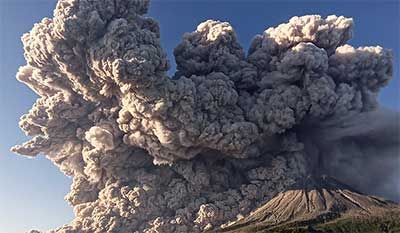GS-1: Important Geophysical Phenomena such as earthquakes, Tsunami, Volcanic activity, cyclone etc.
GS-3: Disaster and Disaster Management,
Key phrases – Mt. Sumeru, volcanic mud, volcanic eruption
Why in news-
-
Mt. Sumeru eruption kills 13 In Indonesia
Analysis:
What is a volcano?
- Place on earth where gases,ashes,lava escape to ground-from asthenosphere of earth- it includes pyroclastic debris,lava,volcanic bomb,ash,dust
- Depending upon the explosive nature of the volcano, different land forms can be formed such as a plateau (if the volcano is not explosive) or a mountain (if the volcano is explosive in nature)
- Volcanoes can be of several types depending upon their explosivity ,shape,size,and location
Origin of volcano
- Volcanic activities are associated with crustal disturbances and mostly take place where the crust has a weak portion because of faulting or folding.
- As we go deep inside crust temperature increases (1°F increase with 65 feet) and so we can expect the interior of the earth in the semi-molten state
- Gases like – carbon dioxide, sulphurated hydrogen, and small proportions of Nitrogen chlorine, and other volatile substances charge magma heavily
Types of volcanoes
- Shield Volcanoes- They are the largest of all volcanoes in the world as the lava flows to a far distance. The Hawaiian volcanoes are the most famous examples. Shield volcanoes have low slopes and consist almost entirely of frozen lavas.
- Cinder Cone Volcanoes- Small volcanoes.These volcanoes consist almost entirely of loose, grainy cinders and almost no lava.
- Composite Volcanoes- consist of layers of solid lava flows mixed with layers of sand- or gravel-like volcanic rock called cinders or volcanic ash.They are characterized by the eruption of a cooler and more viscous lavas than basalt.
- Caldera-These are the most explosive of the earth’s volcanoes.They are usually so explosive that when they erupt they tend to collapse on themselves rather than building any tall structure. The collapsed depressions are called calderas.
- Flood Basalt Provinces-These volcanoes outpour highly fluid lava that flows for long distances.The Deccan Traps from India, presently covering most of the Maharashtra plateau, are a much larger flood basalt province
- Mid-Ocean Ridge Volcanoes-These volcanoes occur in the oceanic areas.There is a system of mid-ocean ridges more than 70,000 km long that stretches through all the ocean basins.

Distribution of volcanoes
- Greatest concentration – circum pacific region (Pacific ring of fire) – Includes 2/3rd world’s volcanoes.
- The Ring of Fire also referred to as the Circum-Pacific Belt, is a path along the Pacific Ocean characterized by active volcanoes and frequent earthquakes.
- Atlantic-Few volcanoes.Many dormant or extinct.Example – Madeira, Ascension, St. Helena
- Asia-Mt. Ararat,Mt. Elbrus (elbows or eyebrows). It’s interesting and surprising that the Himalayas have no active volcanoes
- Africa-Mt. Kilimanjaro and Mt. Kenya (east African rift valley – extinct).Mt. Cameroon – an only active volcano of west Africa.
Effects of volcano eruptions
- Ashes can stay in the stratosphere for about two to five years, and within this period, there are chemical reactions that destroy the stratospheric ozone molecules.
- Volcanoes contribute about 18%-20% of Chlorine entering the atmosphere, this also destroys ozone.
- Volcanoes also cause global warming by releasing greenhouse gases such as water vapour and carbon dioxide into the atmosphere.
- Lava can kill plants and animals. This also contributes to global warming by reducing carbon sink.
- Most of the particles spewed from volcanoes cool the planet by shading incoming solar radiation. The cooling effect can last for months to years causing cooling over large areas of the Earth
Source: The Hindu
Prelims question
Q. Read the given statements
- Barren island is India’s as well as south Asia’s only active volcano.
- Maximum concentration of volcanoes is seen in interiors of continents.
Which of the statements given above is/are correct?
(a) 1 only
(b) 2 only
(c) Both 1 and 2
(d) Neither 1 nor 2
Ans : a
Mains Question
Q. Volcanoes pose a great challenge in nations like Indonesia. What are type of volcanoes, their landforms and dangers they pose? Could they be use sustainably with current technology to harness energy and reverse global warming?









